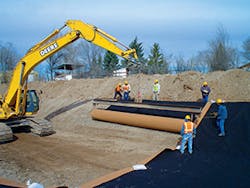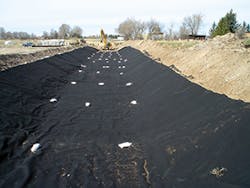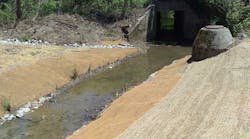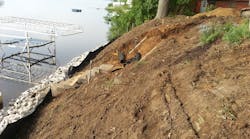The Snake River Valley of eastern Idaho didn’t become an agricultural center until well after the Civil War. The Homestead Act, which became US law in 1862, brought settlers determined to farm to the area.
The Homestead Act allowed any citizen of the US who was the head of the family or over 21 years of age to file a claim on 160 acres of unappropriated land. The claim filer could acquire title to the land by residing upon and cultivating it for five years.
The Snake River provided plenty of water, but it had to be brought closer to the farmers and ranchers. First the settlers cleared the land, then they dug canals and ditches to bring water where it was needed for crops and livestock. The canals played a critical part in the settlement of many parts of the western US. Now they serve an essential function in maintaining agriculture in these states.
One of these canals is the Porter Canal on the edge of what is now the city of Idaho Falls, ID. This canal was dug to supply water for gold mining and some farms. It was named for an investor in the mining firm.
Over the years, relations between the farmers and the companies who owned the canals (and thus controlled the water the farmers needed for watering livestock and irrigating crops) changed. The farmers, many of Swedish descent, decided to form their own water supply company, and the New Sweden Irrigation District began in early 1900.
Wheat, barley, oats, and corn were the first small grain crops planted. Every farm needed these grains as food for people and livestock.
A disciple of Luther Burbank introduced another crop that became dominant in the late 19th century: the russet potato. This variety of potato—what people now call Idaho baking potatoes—thrived in the eastern Idaho climate of warm summers with cool nights.
“We’re right in the middle of the potato-growing area. We also have a lot of grain and alfalfa,” says Kail Sheppard, manager of the New Sweden Irrigation District.
Today the New Sweden Irrigation District manages the Porter Canal and other waterways in an area of 27,489 acres. The district is regulated by the Bureau of Reclamation, which is part of the US Department of the Interior.
“We have a total of 25 different canals. They cover 125 miles,” says Sheppard. “We were the first irrigation district in the state of Idaho. We’re proud of that.”
Operation of New Sweden Irrigation District’s canals is seasonal, following the work of the farmers and ranchers they serve. The canals are filled in mid-April in time for spring planting. After crops are harvested in the fall, the canals are drained (by gravity) and checked and repaired as needed.
“We control the head gate to let water out of the river,” explains Sheppard. “It takes a week to fill the whole system of canals.”
A small section of the Porter Canal adjoins land on which developers wanted to create Snake River Landing, a residential, retail, and office complex. But before development could begin, seepage from the Porter Canal had to be stopped.
Xcell Engineering of Chubbock, ID, was hired to choose a liner for the Porter Canal and oversee its installation in 2007. Sheppard recommended a Canal3 geocomposite liner made by the Huesker Inc., a German firm with American headquarters in Charlotte, NC.
“In some of our canals, these liners have been there for close to 10 years. So far, so good. We have issues with sinkholes caused by underground lava flows,” says Sheppard, adding that wildlife have not bothered the liners.
Xcell’s owner, Paul Bastian, P.E., concurred with Sheppard’s recommendation of Huesker’s Canal3 to line the Porter Canal. “This material was purchased specifically because it was UV-resistant and wouldn’t deteriorate.”
Bastian had used Canal3 on other projects. “I’ve been pleased with it. It works great.”
Canal3‘s distinctive characteristic is its multilayered composition. This geosynthetic material has a top and a bottom layer of nonwoven material. These layers sandwich a polyethylene membrane.
The top and bottom nonwoven layers offer two advantages. They provide greater protection against punctures or rips and also increase interface friction.
Because Canal3 comes from the Huesker factory already multilayered, it can be installed much more quickly than adding separate layers. Shaping and anchoring trenching are sufficient, as excavation is not needed.
The project required 157,500 square feet of Canal3. Porter Canal runs for about 7 miles from the headwaters of the Snake River before it divides into other canals and streams. The portion that was lined was less than a half mile.
The Porter Canal is about 60 feet wide at the top. Its sides slope downward about 7–8 feet. At the bottom it is only about 20 feet across, a convenient width for installing the liner.
Bastian says the project’s major challenge was that “it had to be done quickly, in the early spring between the time the ground thawed and when water would be introduced into the canal. There would be no forgiveness. We had a hard deadline, with [water needed for] growing season approaching.”
The project took about two months. Bastian says the liner was left uncovered because “it was cost-effective and any covering might slide down into the canal. Then it would have to be cleared out and doing that might tear the liner.”
Because Canal3 is not subject to damage by the sun it can be left exposed, as was done at Porter Canal, or buried. If it is covered with shotcrete, Bureau of Reclamation studies show, it should last for 50 years.
Porter Canal
Widening a Highway
Increased traffic brought the need for bridge expansion and widening of Florida’s State Road 415 from two lanes to four. The completed project is located just north of Sanford.
Associated Construction Products (ACP) of Lutz, FL, teamed up with Strata Systems of Cumming, GA, to combine technical expertise and the right geogrid product for this project. The main part of the project involved stabilizing very steep embankments on both sides of a 1.84-mile stretch of the road and a multiuse path on the right side of the road. A secondary part of the project involved stabilization of a slope on a temporary detour, which was nearby on State Road 46.
Finished in 2014, the project took “about a year and a quarter,” says Randy Friloux, P.E., vice president with ACP. “We used a lot of erosion control measures, a lot of reinforced soil, because there were a lot of 1-to-1 slopes.”
The steep slopes and compressible soils caused concern that the road might, sometime in the future, shift and even crack if precast concrete panel retaining walls were used. Florida Department of Transportation (FDOT) officials suggested that 1:1 slope reinforcement with geogrid be used instead.
Porter Canal
Crews from UIG Construction
of Sanford installed Strata’s SG500 primary geogrid layers 2 feet apart vertically. The purpose of this type of geogrid was for the overall stability of the slopes, giving an factory of safety of 1.5.
The Strata Microgrid served as intermediate reinforcement and was placed on 1-foot vertical spacing for the local surficial stability of the 1:1 slope.
Strata geogrid was also installed to stabilize the 1:1 slope of the temporary detour on State Road 46, about a mile in length. This slope’s surface was covered with a synthetic erosion blanket, North American Green C350. Then native Bahia grass sod was laid on top of it.
“Bahia sod is very durable, very hardy. It stands up to drought. The roots dig in and intermingle into the erosion control blanket,” says Friloux.
The project was the largest geogrid slope project in the state of Florida. Total slopes and anchor trench areas measured 300,000 square feet.
Porter Canal
“We had a lot of incidental rain storms and washouts. The weather affected things,” says Friloux.
A surprising aspect of the project to Friloux was “the craftsmanship, which we developed quickly. All of the slope faces were cut by hand to create a uniform slope angle. It was all handiwork.”
He adds, “It took some real craftsmanship, but our guys caught on to it soon. They used hand shovels, cutting the slope face just right.”
These days the entire project “looks fantastic,” says Friloux. And as for geogrids made by Strata, “we use them quite a bit. They offer good technical support.”
Expanding an Airport
Rocky Mountain Metropolitan Airport is situated in Broomfield, CO, between Denver and Boulder. With proximity to these cities the airport has grown quickly and attracted more traffic, especially larger business commuter jets.
To accommodate this type of aircraft meant increasing the length of the runway to meet Federal Aviation Administration (FAA) safety requirements. The FAA paid for the $8 million project that extended the runway 600 feet wide by 1,000 feet long.
Most of the project was done during 2013. Work was shut down in December of that year, resumed in early 2014, and finished that March.
For slope stabilization, Ken Kinnard, manager at Bowman Construction Supply in Denver, recommended GW30V4 Geoweb from Presto Geosystems of
Appleton, WI. “We’ve been using Presto Geo for 10 years,” says Kinnard, adding that he appreciates the always-available engineering support from the manufacturer.
The biggest challenge to the runway extension project was “building a 54-foot-tall retaining wall that is 600 feet long,” he says.
The Geoweb was “used as a veneer, laid on a 1-to-1 slope that was covered in native vegetation—mostly grasses—all the way top to bottom.” It was fastened with Presto’s ATRA Key connection system. “It works like a cufflink,” says Kinnard.
Unlike products that require “pulling pins together with a pneumatic box stapler, Presto Geo’s system is unique in its ease of application,” he explains. ATRA Key connects sections of Geoweb much more quickly than conventional stapling. One person can do the connecting instead of the two needed for stapling, saving time and labor costs. ATRA Key is also safer for workers to use, as there is no chance of accidentally being hit with a staple.
The GW30V4 Geoweb was chosen “for its medium-weight depth, cost-effectiveness, and ability to hold topsoil on steep slopes and allow vegetation to grow very quickly,” says Kinnard.
The GW30V4 comes in sections that measure 8.5 by 27 feet. Two hundred thirty-seven square feet were used on the project.
Reliant Stadium
When Houston’s Reliant Stadium was constructed, it had the NFL’s first retractable roof, first removable turf field, and the largest seating capacity in the league. The stadium was built to serve two major occupants: the Houston Texans professional football league and the Houston Livestock Show and Rodeo.
These two occupants presented an immediate design problem: their flooring requirements were in direct conflict. The Livestock Show and Rodeo needed a concrete floor. The Houston Texans required a real grass field on which to play.
The design concept that pleased both occupants was the use of a modular, removable turf field on top of the concrete floor. The stadium’s retractable roof would allow sunlight to keep the grass growing. But watering the grass on the indoor field could create major drainage problems.
“We had to cover the expansive clay soil that the stadium was built on, to keep it from drying out or getting wetter [from rain or irrigation],” explains Christopher Swires, P.E., project manager with EnviroCon Systems of Houston, TX.
If the expansive clay soil changed, it could shift the $450 million stadium’s foundation. That would, of course, be a very expensive problem, even if it could be corrected satisfactorily.
The solution that kept both tenants happy and protected the stadium’s foundation was to use geosynthetic material. The specific geosynthetic problem-solver for Reliant Stadium was HDPE Smooth Liner, 60 mil thick, which is made by AgruAmerica of Georgetown, SC.
AgruAmerica’s flat die extrusion process allows for the precise thickness control and consistent properties across the roll width. HDPE Smooth Liner comes in thicknesses from 30–100 mil and either all black or black/white.
If more flexibility is required for a project, the LLDPE Smooth Liner comes in thicknesses from 40–100 mil and the same colors. Both liners are rolled on 23-foot-wide plastic cones to make installation easier.
Swires says that AgruAmerica’s HDPE Smooth Liner is “very beefy, very durable. We use it under everything, from ponds to landfills.”
The most difficult part of the project was “just doing it in the midst of a giant stadium being built around us. There were all kinds of cranes and equipment. It was a very congested workplace,” says Swires.
So congested that the work had to be closely coordinated with that of other companies on the site. “We would work on little areas at a time,” explains Swires.
All of the construction had to be done within 30 months by an agreement the developers had with the city of Houston. Installing the underfloor HDPE liner took from late 2001 to mid-year of 2002. Even though the roof was not yet finished, weather was not a problem for the liner crew of six and two project managers.
The Smooth Liner covers the entire area of Reliant Stadium’s playing field plus the first 20 feet beneath the bleacher section of seating. That total area is 115,000 square feet.
Reliant Stadium
As work areas opened, the crew installed the Smooth Liner first underneath the periphery of the floor, then below the drainage system, and then under the flat areas of the field.
Swires says that sections of the Smooth Liner were welded together easily at 200°F. Wherever it was feasible, HDPE strips were embedded in parts of the stadium’s structures so that the liner could be welded to them. Where embedding wasn’t possible, as in the case of the major foundations, the liner was mechanically attached with a stainless steel batten system.
The flexibility of the HDPE Smooth Liner allowed workers to piece sections together easily. They were also able to test their welds nondestructively as the job went along.
Sections laid beneath drainage pipes, for example, were put down well before the rest of the field was lined. When the time came to join old sections with new, welding them together was relatively simple. When heavy equipment damaged liner that had already been laid, the damaged piece could be cut out and a new piece welded in place.
Protecting a Parking Lot
Various types of geosynthetic material play a significant role in the new parking lot at Christ Chapel Bible Church in Ft. Worth, TX. The products provide drainage, prevent erosion, and provide an attractive appearance for the parking lot.
The new parking lot was installed so the church would be in compliance with stormwater regulations. No more hardscape lots that large were permitted. Construction of the project was done by Concrete Paver Systems of Duncanville, TX. Dunaway Associates of Ft. Worth performed engineering for the project.
The project was done in three phases and took about three months to complete in 2014. The work crew numbered six.
“The weather hurt us more than anything,” says Roger Henjum of Concrete Paver Systems. “We had a lot of rain. With a 12-inch or more cut and rain, you can’t get equipment in there. You have to pump it out at the low end and let it dry out.”
The first layer of the installation was a 20-mil nominal HDPE liner from Brawler Industries of Midland, TX. Draincore2 from Invisible Structures of Golden, CO, was installed on top of this impermeable liner. The 70,000 square feet of Draincore2 conveys stormwater runoff from the parking lot to a pipe at the lowest portion of the system. The pipe carries runoff to a sump pump. From there the water flows into the sewer system.
Above the Draincore2 is a layer of geotextile filter fabric. This fabric is GT 160, which comes in rolls 15 by 30 feet, from SKAPS Industries of Athens, GA. Both this fabric and the Brawler liner were supplied by Innovative Soil Solutions of Arlington, TX.
The SKAPS geotextile material allows water to enter the Draincore2 system from any direction. Twelve inches of a base course sit above the geotextile filter fabric.
“It’s a special aggregate, a sandy-gravel mix. The rock is one inch and down to fines,” says Henjum. “It’s not large fines that [would] lock it up and not too small fines that [would] stop it up.”
Above that are 70,000 square feet of Invisible Structures’ Grasspave2. The cells were planted with a native Bermuda-type grass seed.
Draincore2 can be used for both subsurface and green roof applications, and as a replacement for French drains. It is suitable for drainage in foundations, retaining walls, planters, golf greens, and sports turf. Flow rate for Draincore2 is 42 gallons per minute per foot width, twice the conveyance rate of a drainage system with pipes and gravel. The high flow rate is possible because the flexible grid has a 92% void for air or water. Made of durable HDPE, Draincore2 has a high compression strength, 2,100 pounds per square inch gauge.
Draincore2 can be arranged in multiple layers to increase capacity. Its rings can be set vertically or horizontally. It comes in 1-meter-square units or quarter meter square units.
Grasspave2 is durable enough for cars to be driven and parked on it. It looks like a lawn, but works like a concrete or asphalt surface for low-speed, low-use parking areas. It has a compressive strength of 15,940 pounds per square inch gauge.
Suitable sites for Grasspave2 include fire and emergency vehicle lanes, parking lots, overflow lots for stadium and event parking, golf cart paths, helicopter landing pads, and utility or maintenance access lanes.
Grasspave2 also has a large void. This allows room for root growth and storage capacity for stormwater runoff.
A 13-inch cross section (1 inch of Grasspave2 with sand and a 12-inch base course) can store 2.6 inches of water. The large void space allows trees to be planted within parking areas.
The green parking lot at Christ Chapel is only open when church services are held. At all other times, visitors and employees park in a regular impermeable concrete lot.
Judging just from these projects for agriculture, aviation, highway transportation, major construction, and parking, geosynthetics are diverse materials that serve diverse purposes. In many cases they are hidden from view after the projects were completed, but they play essential roles in the continued success of the projects.










